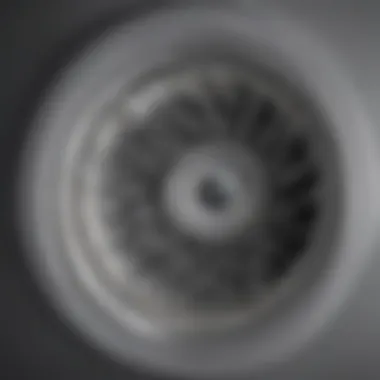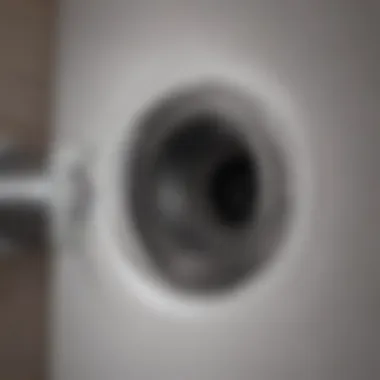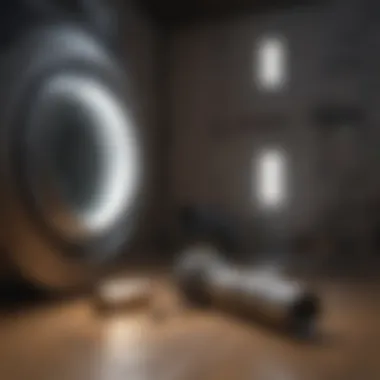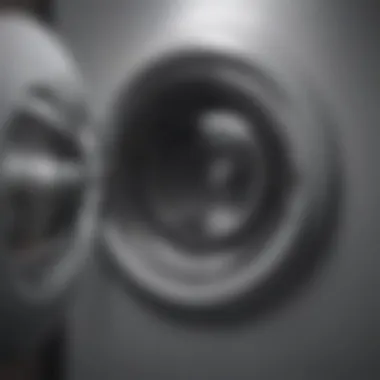Essential Guide to Dryer Vent Maintenance


Intro
Maintaining dryer vents is an often overlooked aspect of home care. Many homeowners do not realize the potential dangers and inefficiencies that arise from neglecting this important task. Lint build-up and poor airflow can lead to various issues, from reduced performance of the dryer to a significantly increased risk of fire. Understanding how to properly maintain dryer vents transforms not just the appliance's functionality but also enhances household safety. This article aims to dissect the intricacies of dryer vent maintenance, providing clear guidelines to empower homeowners.
Importance of Dryer Vent Maintenance
Neglecting dryer vent maintenance can lead to serious consequences. When lint accumulates in the duct, it restricts airflow. This can cause the dryer to work harder, leading to higher energy bills and premature appliance wear. Worst case, a clogged vent may spark a fire. The U.S. Fire Administration reports that failure to clean dryer vents is one of the leading causes of home fires, emphasizing why routine checks are essential.
Always inspect your dryer vent annually to prevent potential hazards and maintain appliance efficiency.
In addition to safety, effective dryer vent maintenance improves dryer efficiency. With an unobstructed vent, clothes dry faster, conserving energy and time. Moreover, proper maintenance prolongs the life of the dryer itself, protecting your investment and enhancing your home’s overall functionality.
How to Check Your Dryer Vent
Step 1: Gather Necessary Tools
To check your dryer vent, you will need a few basic tools:
- Screwdriver
- Vacuum cleaner with a hose attachment
- Duct cleaning brush
- Flashlight
Step 2: Disconnect the Dryer
Before starting, ensure safety by unplugging the dryer and shutting off the gas supply if applicable. Be cautious while maneuvering around the appliance.
Step 3: Inspect the Vent
Once disconnected, visually inspect the vent. Look for lint accumulation at the connection between the dryer and vent. Check for kinks or restrictions in the duct that affects airflow. Use a flashlight for a better view.
Step 4: Clean the Vent
Utilize the vacuum cleaner to remove visible lint and debris. For thorough cleaning, use the duct cleaning brush to reach into the vent. Ensure you clean all the way to the exterior vent cover. A clean vent not only improves airflow but also reduces fire risks.
Step 5: Reconnect and Test
After cleaning, carefully reconnect the dryer and plug it back in. Turn it on for a few minutes and observe. There should be a strong airflow at the vent's exit; any decrease indicates a problem.
Best Practices for Maintenance
To protect your home and enhance dryer efficiency, adopt the following habits:
- Routine Inspections: Check your dryer vent at least once a year.
- Cleaning Schedule: Clean the vent thoroughly every six months, or more if you do many loads.
- Professional Assistance: Consider hiring a professional cleaning service every couple of years for a deep clean.
By incorporating these practices, homeowners not only safeguard their residence but also ensure their dryer operates at peak performance. Efficient dryers are a testament to well-kept equipment.
Culmination
For additional reading, consider resources from Wikipedia and Britannica. Avoiding pitfalls in appliance maintenance empowers households and sustains safety.
Prologue to Dryer Vent Maintenance
Importance of Vent Maintenance
Regular vent maintenance serves several essential purposes. It promotes efficiency in dryer operation, which translates to faster drying times and less energy consumption. An unobstructed vent allows hot air to escape freely, preventing strain on the dryer’s motor and components. Moreover, proper maintenance minimizes the risk of fire hazards caused by lint buildup. Fires can ignite when lint accumulates in dryer vents, creating a dangerous situation that simple inspections could prevent. Therefore, vent maintenance is not only good practice; it is a critical safety concern that every homeowner must address.
Consequences of Neglecting Vent Inspection
Neglecting to inspect and maintain dryer vents can lead to various serious issues. One significant consequence is reduced airflow, which may cause the dryer to overheat and shorten its lifespan. Additionally, lint buildup can trigger frequent overheating cycles, straining the appliance and prompting costly repairs. In extreme cases, neglecting vent inspection could even result in house fires, as lint is highly flammable and can ignite if conditions are right. Homeowners risk not only the loss of their dryers but also the safety of their families and properties. Thus, it is unfathomably clear that regular inspections and maintenance are indispensable for safe and efficient dryer operation.
Understanding Dryer Vent Design
Dryer vent design is fundamental in ensuring the appliance operates effectively and safely. A well-designed dryer vent system facilitates the quick escape of hot, moist air produced during the drying cycle. It also helps in preventing lint build-up, which serves as a major fire hazard. Understanding the specifics of dryer vent design can save homeowners money on energy bills and prolong the lifespan of the dryer.


Components of a Dryer Vent System
A typical dryer vent system consists of several key components that work in unison. These components include:
- Dryer: The appliance that generates heat and moisture.
- Duct: A rigid or flexible tube that channels the air from the dryer to the outside.
- Vent Hood: The external cover that prevents outside elements from entering the duct while allowing air to exit.
- Clamps: Attachments that secure the ducts to the dryer and vent hood.
- Filters: Some systems include lint traps that catch any remaining lint before it reaches the duct.
Each part must work correctly to allow optimal airflow and minimize blockages. Any flaws or restrictions in this system can lead to inefficiency and safety risks. Regular inspection of each component is essential to maintain performance and safety.
Common Materials Used
The materials used to construct dryer vents significantly influence their efficiency and longevity. Common materials include:
- Aluminum: Lightweight and resistant to corrosion, it is the most popular choice. It can be found in both rigid and flexible forms.
- Steel: More durable than aluminum, galvanized steel is often used in rigid ducts. It provides excellent air flow but can be heavy.
- Plastic: Not recommended for dryer vents as they may warp under heat and can catch fire. However, some non-combustible plastic materials are available.
- Flexible Ducting: This material allows for easier installation but must be monitored for kinks, which can restrict airflow.
Understanding these materials can help in selecting the right type for your home, maximizing efficiency and safety.
Identifying Vent Issues
Identifying vent issues is critical for maintaining dryer efficiency and safety. Many homeowners might overlook this aspect, but understanding how to spot potential problems can save time, money, and even prevent dangerous situations like fires. By learning to recognize the signs of blockage and symptoms of poor airflow, readers can take proactive measures in vent maintenance.
Signs of Blockage
Blockage in a dryer vent can result in various efficiency problems or hazards. Here are some key indicators to watch for:
- Longer Drying Times: If clothes take over an hour to dry, this might suggest that air isn't flowing properly.
- Lint Accumulation: Finding lint around the dryer or at the vent outlet is a clear warning sign. Regular checks can help prevent this issue.
- Burning Smell: If there's a noticeable smell while the dryer operates, it may indicate overheating due to a clogged vent.
- Hot Dryer Door: The exterior of the dryer feels hot to the touch, which means the machine is working harder to produce heat and may be a sign of blockage.
If these signs appear, it is urgent to inspect the vent system. A simple understanding of airflow dynamics can help homeowners maintain optimal dryer function.
Symptoms of Poor Airflow
Poor airflow affects drying performance significantly. Homeowners should be vigilant to detect airflow issues through the following symptoms:
- Low Air Volume from Vent: If the airflow from the vent feels weak, this might indicate a serious obstruction.
- Condensation Issues: A build-up of moisture around the dryer, indicative of inefficient airflow, leads to potential mold issues.
- Dryer Runs Longer but Doesn't Dry: If the machine is cycling but clothes remain damp, it points towards airflow interference.
- Thumping or Vibrating Noises: Unusual noises can signal that the dryer is struggling to push air through the vent.
Regular observations and routine checks can pinpoint these problems timely. Maintaining awareness about these symptoms assists in preserving dryer efficiency and extending its lifespan.
Tools Required for Vent Checking
Vent checking is a critical step in maintaining dryer efficiency and safety. The right tools are essential to effectively assess the condition of dryer vents. Properly equipped, you can identify problems such as lint build-up or damage to ductwork, limiting airflow. This vigilance not only enhances dryer performance but also reduces fire hazards, which is a significant concern for many homeowners.
Having the correct tools at hand streamlines the inspection process and allows for thorough documentation of any necessary repairs. While some tools may seem basic, even simple measurements can reveal underlying issues that require immediate attention. Therefore, understanding what tools are essential for vent checking cannot be overstated.
Essential Tools List
To efficiently conduct a dryer vent inspection, consider the following tools:
- Lint brush: An important tool for removing lint from the vent and ductwork.
- Screwdriver set: Necessary for opening the vent cover and accessing duct connections.
- Measuring tape: Helps to measure the length and diameter of ductwork for assessing airflow efficiency.
- Vacuum cleaner with hose attachment: Effective for sucking out accumulated lint from vent interiors.
- Flashlight: Aids in illuminating dark areas during inspection, ensuring a thorough examination.
- Inspection camera: Useful for detailed visual inspections of inside the ductwork, even in hard-to-reach areas.
Each of these tools plays a vital role in promoting efficient dryer vent maintenance.
Safety Equipment
Safety should always be a priority when checking dryer vents. The use of specific safety equipment minimizes the risk of injury and ensures a safe working environment. Vent inspections might involve reaching into tight spaces or handling potentially hazardous materials. Consider the following safety equipment:
- Gloves: Protects hands from sharp edges when working on metal ducts and prevents contact with lint.
- Safety goggles: Important for eye protection against dust and debris during the inspection.
- Dust mask or respirator: Helps to avoid inhaling lint particles or dust, especially during cleaning.
- Knee pads: Useful for comfort when kneeling on hard surfaces during inspections.
Investing in suited safety equipment can significantly reduce the risk of accidents as you maintain your dryer vents.
By being properly equipped with the right tools and safety gear, you enhance your ability to conduct efficient and thorough dryer vent inspections.
Step-by-Step Guide to Checking Dryer Vents
Maintaining a dryer vent is essential for both safety and efficiency. This guide walks you through the process of checking your dryer vents step by step. By following these steps, you can ensure that your dryer operates effectively, reduces the risk of fire hazards associated with lint build-up, and helps you save on energy costs. Regular vent checks improve airflow, allowing your dryer to dry clothes quicker, leading to an overall better experience.


Preparing the Dryer for Inspection
Before starting the inspection, it's crucial to prepare the dryer for a safe evaluation.
- Unplug the Dryer: Always ensure the dryer is disconnected from the power source to prevent accidents.
- Move the Dryer: Carefully pull your dryer away from the wall to access the vent duct.
- Gather Tools: Make sure you have the necessary tools on hand before you begin. You will need a screwdriver, a vacuum cleaner with a hose attachment, and a flashlight.
Taking these preparatory steps helps in carrying out a thorough and safe inspection.
Accessing the Vent
After preparing the dryer, the next step is to access the vent system for a detailed check.
- Remove the Vent Hose: Use a screwdriver to loosen the clamps or screws holding the vent hose in place. Gently disconnect the hose from both the dryer and the external vent.
- Inspect the Vent Exit: Check the area where the vent duct exits the home. Make sure the vent cap is operational and free of any obstructions like debris or animals.
- Examine Clip Points: Ensure that all connections along the duct are secure. Any loose connections can lead to airflow problems.
Gaining access to the entire vent system is critical for a complete evaluation.
Visual Inspection of the Vent System
Once you have access, conduct a visual inspection of the vent system.
- Look for Cracks or Dents: Inspect the ductwork for any visible wear and tear. Cracks or dents can restrict airflow and promote lint accumulation.
- Check Duct Length: Ensure the duct is not excessively long. If it stretches more than 25 feet, airflow will likely be compromised.
- Evaluate Duct Material: Check if the vent uses the right materials. Aluminum or rigid metal is ideal; avoid plastic or vinyl as they are highly flammable.
This step is important to assess the overall condition of the vent.
Checking for Lint Accumulation
Lint accumulation is a common problem that can seriously affect dryer performance.
- Use a Vacuum Attachment: Insert a vacuum cleaner hose into the vent to remove any lint or debris. This should be done both inside and outside the vent where possible.
- Inspect Lint Trap: Check the lint trap inside the dryer itself. A clogged lint trap can cause issues also, so it’s important to clean it before usage.
- Perform a Lint Check in Duct: Depending on the design of your vent, you might want to use a flexible brush to clean areas that are hard to reach.
Regular cleaning prevents major blockages and enhances airflow.
Testing Airflow
Finally, test the airflow to ensure that the dryer vent is functioning optimally.
- Reconnect the Vent: Attach the vent back to the dryer and the exit point.
- Turn on the Dryer: Set it to a high heat setting and check the airflow at the vent exit. You should feel a strong stream of air.
- Monitor for Smell or Heat: If you notice any unusual smells or excessive heat emanating from the duct during operation, cut the power and re-inspect the entire system.
Testing the airflow is a critical final check to ensure all systems are operational and safe.
Remember: Regular inspection and maintenance of dryer vents can save you from fire hazards and improve the longevity of your appliance.
By following this step-by-step guide, you can maintain a safe and effective dryer vent system, ultimately enhancing your drying experience.
Common Dryer Vent Problems
Addressing common dryer vent problems is critical for ensuring the safety and efficiency of your dryer. Recognizing these issues helps in preventing potential hazards such as fire risks and appliance malfunction. Each issue can contribute to inefficient drying, increased energy consumption, and can lead to costly repairs if left unchecked. Thus, understanding these problems is essential not only for optimal performance but also for prolonging the lifespan of your dryer.
Lint Build-Up
Lint build-up is one of the most prevalent issues affecting dryer vents. Over time, lint can accumulate in the venting system, blocking airflow. This blockage can lead to several complications including longer drying times, increased energy consumption, and the potential for fires. The U.S. Fire Administration reports that failure to clean dryer vents is one of the leading causes of home dryer fires.
To mitigate lint build-up, regular inspections and cleaning are necessary. Homeowners should consider cleaning their dryer lint trap after each use and schedule a thorough cleaning of the vent system at least once a year. The use of specialized lint removal tools can assist in this process, ensuring that lint does not obstruct airflow.
Improper Duct Configuration
Improper duct configuration can cause several airflow issues in dryer vent systems. When ducts are too long, twisted, or have too many bends, the dryer must work harder to push air through the vent. This can lead to overheating and further aggravate lint build-up. An ideal dryer duct should be as straight as possible with minimal turns to facilitate efficient airflow.
In addition to affecting airflow, using the wrong materials, such as plastic or vinyl ducts, can be dangerous. These materials can pose fire risks when exposed to high heat generated by dryers. Changing to metal ducting, particularly rigid metal ducts, can improve airflow significantly and reduce risks associated with less suitable materials. Homeowners should assess their duct configurations periodically and make adjustments as necessary to maintain optimal performance.
Damaged Vents
Damaged vents either from wear and tear, improper installation, or even animal intrusions can severely impact dryer functionality. Dents, cracks, or holes in the vent can lead to leaks, allowing moisture to enter and potentially cause mold growth or damage to the walls and surrounding areas. Similarly, if critters enter through openings, they can build nests, exacerbating blockage issues.


It’s crucial to inspect both the inside and outside of the vent system for any signs of damage. If any damages are found, it is advisable to replace the affected sections immediately. Frequent checks will help keep the vent system in good condition, ensuring it operates effectively without significant risks.
"Neglecting to address common dryer vent problems can lead to inefficiencies and significant safety hazards."
Preventative Maintenance Practices
Preventing issues before they arise is essential when maintaining dryer vents. Engaging in preventative maintenance can save time, money, and potential hazards associated with poorly functioning dryer systems. Regularly checking and servicing the vent system minimizes the risk of lint accumulation, which can lead to dangerous situations such as fire hazards. Also, it helps in achieving optimal efficiency, reducing energy usage, and extending the lifespan of the dryer.
Routine Inspection Timeline
Establishing a routine inspection timeline is a key aspect of effective dryer vent maintenance. A good rule of thumb is to check your dryer vents at least every six months. During these inspections, look for any visible lint build-up and ensure airflow is unobstructed. If your dryer is heavily used, consider checking more frequently. Keeping a schedule not only simplifies the task but also helps in tracking any changes or issues that may arise over time.
Inspection Checklist:
- Inspect the vent for visible obstructions.
- Assess the condition of vent components.
- Ensure the exterior vent flap opens and closes freely.
- Evaluate the overall airflow while the dryer is running.
By adhering to a consistent inspection schedule, homeowners can intervene early, preventing more serious issues later on.
Cleaning Procedures
Regular cleaning is a critical element for maintaining dryer vents, and it should be done carefully and thoroughly. Cleaning prevents lint build-up, which is the primary cause of dryer inefficiency and fire risks. Most cleaning methods are straightforward and may only require basic tools. Here are the steps for an effective cleaning process:
- Unplug the Dryer: Always begin by disconnecting the dryer from its power source to ensure safety.
- Access the Vent Duct: Move the dryer away from the wall and detach the duct from the back of the appliance.
- Remove Loose Lint: Use a vacuum cleaner with a hose attachment to remove lint from the duct. This step is critical as even small lint accumulations can cause problems.
- Clean with a Brush: For deeper cleaning, use a dryer vent cleaning brush. Insert it into the duct and rotate to dislodge any stuck lint.
- Reassemble Components: Once cleaning is complete, reattach the duct securely, ensuring that all connections are tight.
- Run a Test Cycle: Finally, plug the dryer back in and run a short cycle to check airflow.
Regular cleaning of dryer vents not only promotes safety but also enhances efficiency, allowing the appliance to perform optimally.
Emphasizing these practices guarantees that your dryer runs effectively and safely. Proper maintenance routines lead to better air quality and prevent costly repairs down the line.
Professional Vent Cleaning Services
Professional vent cleaning services play a significant role in ensuring the safe and efficient operation of your dryer. While routine maintenance is crucial, enlisting experts for comprehensive cleaning can enhance operational performance and extend the lifespan of your appliance. These services remove built-up lint and debris that may not be easily accessed during standard checks.
When to Call a Professional
Determining the right time to call a professional can be pivotal for maintaining the integrity of your dryer system. Here are some key indicators that suggest it's time to seek expert help:
- Your dryer takes longer than usual to dry clothes.
- You notice your clothes are hotter than normal at the end of a cycle.
- The dryer emits a burning smell during operation.
- There is an increase in lint accumulation around the dryer.
- The vent itself is visibly damaged or poorly configured.
Recognizing these signs early can prevent more severe issues like dryer fires or costly repairs.
Choosing the Right Service Provider
Selecting the right service provider can make all the difference in the quality of maintenance your dryer receives. Here are some factors to consider when choosing a professional vent cleaning service:
- Credentials and Certifications: Look for companies that provide proof of training and certification relevant to dryer vent cleaning and safety standards.
- Experience: Research the length of time the company has been in business and their expertise in handling various dryer models and issues.
- Customer Reviews: Read testimonials and reviews on platforms like Reddit or Facebook to assess the satisfaction of past clients.
- Insurance: Verify that the service provider carries liability insurance to protect you in the event of unexpected damages during the cleaning process.
- Comprehensive Services: Ensure the company offers a full range of services, including inspection, cleaning, and necessary repairs, instead of just a basic cleaning.
"A well-maintained dryer vent system is essential for ensuring safety and efficiency during laundry routines."
By carefully evaluating potential service providers, you can ensure that your dryer vents are in capable hands, leading to improved performance and safety.
The End and Final Thoughts
Maintaining dryer vents is an essential practice that cannot be overlooked. The implications of neglecting this maintenance go beyond mere appliance efficiency. They can lead to serious hazards, including house fires sparked by lint accumulation. This article highlights the importance of regularly inspecting and cleaning dryer vents to ensure safe and efficient operation. Through systematic checks and balances, home and property owners can enjoy peace of mind knowing that their dryers operate effectively and do not pose safety risks.
Reviewing Key Points
Throughout this article, several key points were discussed:
- Essential for Safety: Regular dryer vent maintenance prevents lint build-up, which is a leading cause of dryer fires.
- Improving Efficiency: Clean vents enhance airflow, reducing drying time and energy consumption, which can result in lower utility bills.
- Identification of Issues: Recognizing the signs of blockage and poor airflow allows timely action to be taken, preventing escalating problems.
- Effective Cleaning Practices: Implementing both self-checks and hiring professional services ensures thorough maintenance that promotes longevity of the dryer.
By addressing these critical areas, readers can maintain operational efficiency and prioritize safety in their homes.
Encouraging Mindful Maintenance
Mindful maintenance is a habit that should be fostered by all dryer owners. Here are some ways to develop a routine:
- Schedule regular inspections, ideally every six months, to check for lint accumulation and airflow issues.
- Develop a cleaning routine, which includes using proper tools like lint brushes and vacuum attachments to remove lint effectively.
- Stay informed about your dryer model. Different brands may have specific maintenance requirements or recommendations.
By applying the principles outlined in this article, readers enhance not just their appliance's functionality, but they also contribute to a safer residential environment. Maintaining dryer vents is both a foundation of good practice and an investment in home safety.



